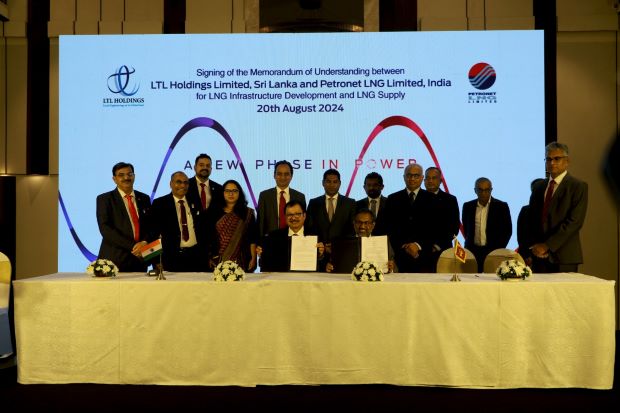COLOMBO – Sri Lanka’s LTL Holdings and India’s Petronet LNG Limited (PLL) signed a Memorandum of Understanding (MOU) on Tuesday (20) to build LNG Infrastructure Development and LNG Supply to Sri Lanka.
A statement from the Indian High Commission in Sri Lanka said the MoU focused on providing an innovative solution encompassing the supply of LNG through a multimodal ISO Container supply chain. It involves the development of LNG unloading, storage, and regasification facilities at Kerawalapitiya, Colombo and the supply of LNG from PLL’s Kochi LNG Terminal through LNG ISO tank containers for power generation facilities of Sobadhanavi Power Plant in Sri Lanka.
The MoU was signed in the presence of Kanchana Wijesekara, Minister of Power and Energy and Dr. Satyanjal Pandey, Deputy High Commissioner, High Commission of India in Sri Lanka along with senior officials from the Government of Sri Lanka.
Under the terms of the MoU, PLL will explore LNG supplies to fuel the 230 MW gas turbines at Kerawalapitiya, ensuring cleaner and reliable and round-the-clock power generation.
The statement noted that the collaboration marks a new chapter in the energy partnership between India and Sri Lanka, reflecting the shared commitment to strengthening energy security for Sri Lanka and promoting reliable, cleaner and sustainable energy supplies, as key economic enablers for Sri Lanka’s development.
A statement from the Ministry of Power and Energy said the MoU signing ceremony marked a significant milestone in Sri Lanka’s journey toward cleaner and more sustainable power generation/
“This MOU covers for a joint development by LTL and PLL to develop necessary infrastructure and supply of LNG for initially for Sobadhanavi Power Plant at Kerawalapityta which will be commissioned shortly,” it said adding that the proposal submitted by both parties was an interim solution to introduce LNG for power generation in Sri Lanka on initiation by both governments of Sri Lanka and India.
Sri Lanka, which witnessed a more than double hike in electricity tariff after its unprecedented economic crisis, has been looking to reduce the generation cost as the price hike has made the government unpopular among the people.
-ENCL



Comments are closed, but trackbacks and pingbacks are open.